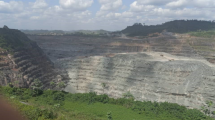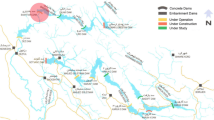Abstract
This paper is aimed to develop and verify a novel hybrid intelligent model, which is indeed a new version of GMDH algorithm and named generalized structure of GMDH (GS-GMDH) to solve engineering problems. The proposed GS-GMDH model was validated its capability of predicting blast-induced ground vibration, a very important safety issues in the mining industry. For this regard, a data set with a totally of 96 samples was gathered from a blasting site in Shur River Dam region, Iran. Among them, 67 and 29 samples were used for constructing and testing the model, respectively. To check the accuracy and robustness of the proposed algorithm, the values of the performance evaluation measures, i.e., R2, variance accounted for (VAF), mean absolute error, root mean square error, scatter index, and Nash–Sutcliffe model efficiency (EN–S), were used. The results showed the efficiency of the GS-GMDH algorithm in the prediction of the blast-induced ground vibration. It was also confirmed that the proposed algorithm can be applied effectively to solving/predicting the engineering problems and it has also the potential to be generalized to other fields.














Similar content being viewed by others
References
Elevli B, Arpaz E (2010) Evaluation of parameters affected on the blast induced ground vibration (BIGV) by using relation diagram method (RDM). Acta Montan Slovaca 15(4):261–268
Hasanipanah M, Armaghani DJ, Amnieh HB, Majid MZA, Tahir MMD (2017) Application of PSO to develop a powerful equation for prediction of flyrock due to blasting. Neural Comput Appl 28(1):1043–1050
Rad HN, Hasanipanah M, Rezaei M, Eghlim AL (2018) Developing a least squares support vector machine for estimating the blast-induced flyrock. Eng Comput 34(4):709–717
Faradonbeh RS, Hasanipanah M, Amnieh HB, Armaghani DJ, Monjezi M (2018) Development of GP and GEP models to estimate an environmental issue induced by blasting operation. Environ Monit Assess 190(6):351
Hasanipanah M, Armaghani DJ, Amnieh HB, Koopialipoor M, Arab H (2018) A risk-based technique to analyze flyrock results through rock engineering system. Geotech Geol Eng 36:2247–2260
Roy PP (1993) Putting ground vibration predictors into practice. J Colliery Guard 241:63–67
Rai R, Singh TN (2004) A new predictor for ground vibration prediction and its comparison with other predictors. Indian J Eng Mater Sci 11:178–184
Hasanipanah M, Monjezi M, Shahnazar A, Jahed Armaghani D, Farazmand A (2015) Feasibility of indirect determination of blast induced ground vibration based on support vector machine. Measurement 75:289–297
Hasanipanah M, Shirani Faradonbeh R, Bakhshandeh Amnieh H, Jahed Armaghani D, Monjezi M (2017) Forecasting blast induced ground vibration developing a CART model. Eng Comput 33(2):307–316
Hasanipanah M et al (2016) Prediction of an environmental issue of mine blasting: an imperialistic competitive algorithm-based fuzzy system. Int J Environ Sci Technol. https://doi.org/10.1007/s13762-017-1395-y
Singh TN (2004) Artificial neural network approach for prediction and control of ground vibrations in mines. Min Technol 113(4):251–256
Hasanipanah M, Golzar SB, Larki IA, Maryaki MY, Ghahremanians T (2017) Estimation of blast-induced ground vibration through a soft computing framework. Eng Comput 33(4):951–959
Hasanipanah M, Naderi R, Kashir J, Noorani SA, Zeynali Aaq Qaleh A (2017) Prediction of blast produced ground vibration using particle swarm optimization. Eng Comput 33(2):173–179. https://doi.org/10.1007/s00366-016-0462-1
Duvall WI, Petkof BB (1959) Spherical propagation of explosion generated strain pulses in rock. US Bur Mines, RI, p 5483
Langefors U, Kihlstrom B (1963) The modern technique of rock blasting. Wiley, New York
Davies B, Farmer IW, Attewell PB (1964) Ground vibrations from shallow sub-surface blasts. Engineering 217:553–559
Gupta RN, Pal Roy P, Singh B (1987) On a blast induced blast vibration predictor for efficient blasting. In: Proceedings of the 22nd international conference on safety in mines research institute, Beijing, China, pp 1015–1021
Mohammadhassani M, Nezamabadi-pour H, Shariati M, Suhatril M (2013) Identification of a suitable ANN architecture in predicting strain in tie section of concrete deep beams. Struct Eng Mech 46(6):853–868
Toghroli A, Mohammadhassani M, Shariati M, Suhatril M, Ibrahim Z, Ramli Sulong NH (2014) Prediction of shear capacity of channel shear connectors using the ANFIS model. Steel Compos Struct J 17(5):623–639
Safa M et al (2016) Potential of adaptive neuro fuzzy inference system for evaluating the factors affecting steel-concrete composite beam’s shear strength. Steel Composite Struct 21(3):679–688
Mansouri I, Shariati M, Safa M, Ibrahim Z, Tahir MM, Petković D (2017) Analysis of influential factors for predicting the shear strength of a V-shaped angle shear connector in composite beams using an adaptive neuro-fuzzy technique. J Intell Manuf. https://doi.org/10.1007/s10845-017-1306-6
Toghroli A (2015) Applications of the ANFIS and LR models in the prediction of shear connection in composite beams. Universiti Malaya, Kuala Lumpur
Chahnasir ES et al (2018) Application of support vector machine with firefly algorithm for investigation of the factors affecting the shear strength of angle shear connectors. Smart Struct Syst 22(4):413–424
Sedghi Y et al (2018) Application of ANFIS technique on performance of C and L shaped angle shear connectors. Smart Struct Syst 22(3):335–340
Sari PA et al (2018) An intelligent based-model role to simulate the factor of safe slope by support vector regression. Eng Comput. https://doi.org/10.1007/s00366-018-0677-4
Khandelwal M (2011) Blast-induced ground vibration prediction using support vector machine. Eng Comput 27:193–200
Mohamadnejad M, Gholami R, Ataei M (2012) Comparison of intelligence science techniques and empirical methods for prediction of blasting vibrations. Tunn Undergr Space Technol 28:238–244
Ghasemi E, Ataei M, Hashemolhosseini H (2013) Development of a fuzzy model for predicting ground vibration caused by rock blasting in surface mining. J Vib Control 19(5):755–770
Radojica L et al (2014) Prediction of blast-induced ground motion in a copper mine. Int J Rock Mech Min Sci 69:19–25
Hajihassani M, Jahed Armaghani D, Marto A, Tonnizam Mohamad E (2015) Ground vibration prediction in quarry blasting through an artificial neural network optimized by imperialist competitive algorithm. Bull Eng Geol Environ 74:873–886
Hajihassani M, Jahed Armaghani D, Monjezi M, Mohamad ET, Marto A (2015) Blast-induced air and ground vibration prediction: a particle swarm optimization-based artificial neural network approach. Environ Earth Sci 74:2799–2817
Jahed Armaghani D, Momeni E, Abad SVANK, Khandelwal M (2015) Feasibility of ANFIS model for prediction of ground vibrations resulting from quarry blasting. Environ Earth Sci 74:2845–2860
Monjezi M, Hasanipanah M, Khandelwal M (2013) Evaluation and prediction of blast-induced ground vibration at Shur River Dam, Iran, by artificial neural network. Neural Comput Appl 22(7–8):1637–1643
Hasanipanah M, Amnieh HB, Arab H, Zamzam MS (2018) Feasibility of PSO–ANFIS model to estimate rock fragmentation produced by mine blasting. Neural Comput Appl 30(4):1015–1024
Gao W, Karbasi M, Hasanipanah M, Zhang X, Guo J (2018) Developing GPR model for forecasting the rock fragmentation in surface mines. Eng Comput 34(2):339–345
Hasanipanah M, Amnieh HB, Arab H, Zamzam MS (2018) Feasibility of PSO–ANFIS model to estimate rock fragmentation produced by mine blasting. Neural Comput Appl 30(4):1015–1024
Haykin S (1999) Neural networks: a comprehensive foundation. Prentice Hall, Upper Saddle River
Ebtehaj I, Bonakdari H, Gharabaghi B (2018) Development of more accurate discharge coefficient prediction equations for rectangular side weirs using adaptive neuro-fuzzy inference system and generalized group method of data handling. Measurement 116:473–482
Ebtehaj I, Bonakdari H, Sharifi A (2014) Design criteria for sediment transport in sewers based on self-cleansing concept. J Zhejiang Univ Sci A 15(11):914–924
Jahed Armaghani D, Hasanipanah M, Bakhshandeh Amnieh H, Mohamad ET (2016) Feasibility of ICA in approximating ground vibration resulting from mine blasting. Neural Comput Appl 1:2–3. https://doi.org/10.1007/s00521-016-2577-0
Hasanipanah M, Shahnazar A, Arab H, Golzar SB, Amiri M (2017) Developing a new hybrid-AI model to predict blast induced backbreak. Eng Comput 33(3):349–359
Mahdiyar A et al (2017) A Monte Carlo technique in safety assessment of slope under seismic condition. Eng Comput 33(4):807–817
Hasanipanah M et al (2017) Development of a precise model for prediction of blast-induced flyrock using regression tree technique. Environ Earth Sci 76(1):27
Mansouri I et al (2018) Strength prediction of rotary brace damper using MLR and MARS. Struct Eng Mech 60(3):471–488
Shariat M, Shariati M, Madadi A, Wakil K (2018) Computational Lagrangian multiplier method by using for optimization and sensitivity analysis of rectangular reinforced con crete beams. Steel Compos Struct 29(2):243–256
Keshtegar B, Hasanipanah M, Bakhshayeshi I, Sarafraz ME (2019) A novel nonlinear modeling for the prediction of blast induced airblast using a modified conjugate FR method. Measurement 131:35–41
Yang Y, Zang O (1997) A hierarchical analysis for rock engineering using artificial neural networks. Rock Mech Rock Eng 30:207–222
Author information
Authors and Affiliations
Corresponding author
Additional information
Publisher’s Note
Springer Nature remains neutral with regard to jurisdictional claims in published maps and institutional affiliations.
Rights and permissions
About this article
Cite this article
Jahed Armaghani, D., Hasanipanah, M., Bakhshandeh Amnieh, H. et al. Development of a novel hybrid intelligent model for solving engineering problems using GS-GMDH algorithm. Engineering with Computers 36, 1379–1391 (2020). https://doi.org/10.1007/s00366-019-00769-2
Received:
Accepted:
Published:
Issue Date:
DOI: https://doi.org/10.1007/s00366-019-00769-2




